|
Show all abstracts Show selected abstracts Add to my list |
|
| REVIEW ARTICLE |
|
|
|
Surgical techniques of laparoscopic inguinal hernia repair in childhood: A critical appraisal |
p. 1 |
Christopher S Lukong
DOI:10.4103/2006-8808.100343 PMID:23066453Laparoscopic inguinal hernia repair started over two decades ago. It has been gaining ground as a mode of treatment for inguinal hernia in children. Several surgical techniques have emerged since its inception. The aim of this article is to review the role of laparoscopy in inguinal hernia repair in children, the various emerging laparoscopic surgical techniques, and their current trend in pediatric surgical practice. In this study, extensive review and analysis of recent articles on laparoscopic inguinal hernia repair in children revealed that laparoscopy plays a great role in the treatment of inguinal hernia in children. There were several emerging laparoscopic techniques, with trends toward extracorporeal suturing and knotting technique and single-port access technique as well. The recent advance is toward the use of tissue adhesives in laparoscopic inguinal hernia repair in children. |
| [ABSTRACT] [HTML Full text] [PDF] [Mobile Full text] [EPub] [Citations (5) ] [PubMed] [Sword Plugin for Repository]Beta |
|
|
|
|
|
|
| ORIGINAL ARTICLES |
 |
|
|
  |
Assessment of speech in primary cleft palate by two-layer closure (Conservative management) |
p. 6 |
Harsha Jain, Dayashankara Rao, Shailender Sharma, Saurabh Gupta
DOI:10.4103/2006-8808.100344 PMID:23066454Treatment of the cleft palate has evolved over a long period of time. Various techniques of cleft palate repair that are practiced today are the results of principles learned through many years of modifications. The challenge in the art of modern palatoplasty is no longer successful closure of the cleft palate but an optimal speech outcome without compromising maxillofacial growth. Throughout these periods of evolution in the treatment of cleft palate, the effectiveness of various treatment protocols has been challenged by controversies concerning speech and maxillofacial growth. In this article we have evaluated the results of Pinto's modification of Wardill-Kilner palatoplasty without radical dissection of the levator veli palitini muscle on speech and post-op fistula in two different age groups in 20 patients. Preoperative and 6-month postoperative speech assessment values indicated that two-layer palatoplasty (modified Wardill-Kilner V-Y pushback technique) without an intravelar veloplasty technique was good for speech. |
| [ABSTRACT] [HTML Full text] [PDF] [Mobile Full text] [EPub] [PubMed] [Sword Plugin for Repository]Beta |
|
|
|
|
|
|
Total arterial off-pump coronary revascularization with a bilateral internal mammary artery Y graft (208 cases) |
p. 10 |
Jun-Feng Yang, Hong-Chao Zhang, Cheng-Xiong Gu, Hua Wei
DOI:10.4103/2006-8808.100345 PMID:23066455Objective: The aim was to evaluate the early outcome of off-pump coronary artery bypass grafting (OPCABG) with a bilateral internal mammary artery (BIMA) Y configuration graft to achieve total arterial myocardial revascularization. Materials and Methods: From October 2002 to December 2008, 208 patients (196 male and 12 female patients) underwent OPCABG by only using a BIMA Y configuration graft. The average age of the patients was 56.5±11.3 years, with the age range being 33-78 years. A total of 167 (80.2%) cases had triple-vessel disease. Left main stem disease was found in 33 (15.9%) cases, and double-vessel disease was found in 8 (3.9%) cases. The semiskeletonization skill was used to harvest the two IMAs, and then the free right internal mammary artery was anastomosed end-to-side to the in situ left internal mammary artery to composite a Y configuration graft. Off-pump and sequential anastomosis methods were used to perform coronary artery bypass surgery for the patients. Graft patency was assessed by using the HT311 transit time flowmeter (USA Transonic Systems Inc.), intraoperatively. Results: We performed distal anastomoses of the grafts in 728 patients, the average being 3.5±1.3 per person. No one died and got recurrent angina within 30 days after operation. Conclusion: OPCABG by using the BIMA Y graft was safe and effective to achieve total arterial revascularization, and avoid surgical operation on the ascending aorta, and other incisions. |
| [ABSTRACT] [HTML Full text] [PDF] [Mobile Full text] [EPub] [Citations (1) ] [PubMed] [Sword Plugin for Repository]Beta |
|
|
|
|
|
|
| SURGICAL TECHNIQUES |
 |
|
|
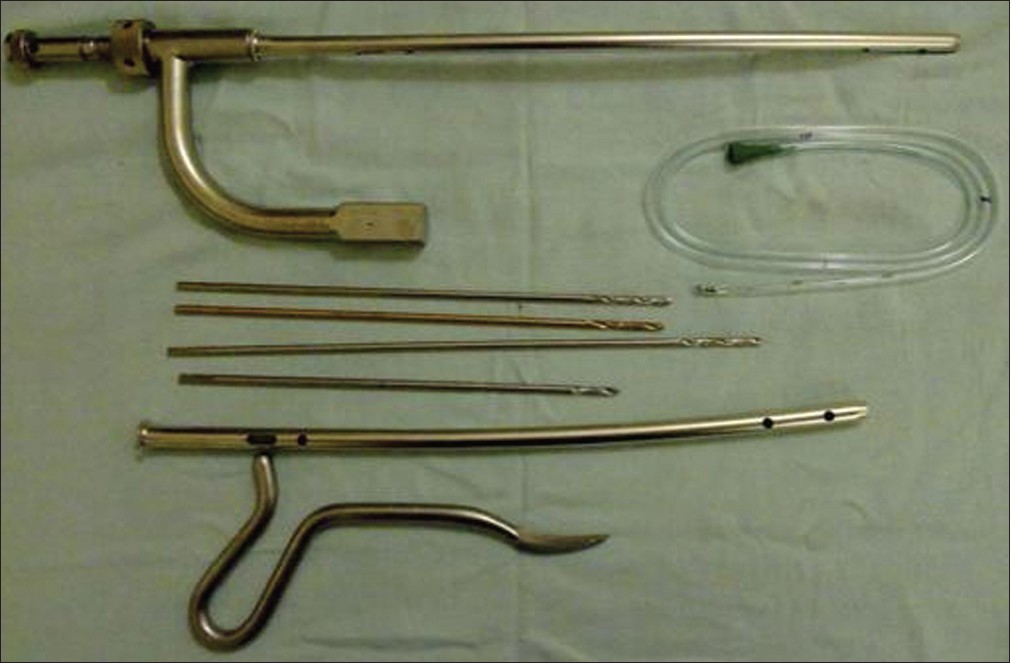  |
Radiation-free insertion of distal interlocking screw in tibial and femur nailing: A simple technique |
p. 15 |
Ritesh Kumar Soni, Surender Mohan Mehta, Bhanu Awasthi, Janith Lal Singh, Amit Kumar, Lokesh Thakur, Sujit Kumar Tripathy
DOI:10.4103/2006-8808.100346 PMID:23066456Background: Distal interlocking screw insertion in intramedullary nailing of long-bone fracture is a challenging task for orthopedic surgeons. It is difficult particularly when the surgeon is in his learning stage or when image intensifier is not available. We describe a radiation-free technique of distal interlocking screw insertion which is easy and practicable. Materials and Methods: In this technique, a same length nail is placed over the skin (outer nail) and through its distal-most screw hole, a 3.2 mm drill bit is inserted to drill the distal locking screw hole of the intramedullary nail (inner nail). With a small skin incision over the distal screw holes, the distal-most screw hole is identified; the bone window overlying the screw hole is widened with an awl and a locking bolt is inserted with a washer under direct visualization. The other distal interlocking screw is simply drilled by matching the other three holes of the outer and inner nails. We have operated 86 patients (39 femoral shaft fracture and 47 tibial shaft fracture) in 1 year where this technique was used. There were 41 open fracture and 45 closed fracture. Results: Within 6 months of follow-up, bony union was achieved in 36 of 39 femur fractures and 45 of 47 tibial fractures. No unwanted complications were observed during the postoperative period and in follow-up. Conclusion: This method of radiation-free distal interlocking screw insertion is simple and can be used in third world country where image intensifier facility is not available. However, surgeons are encouraged to use image intensifier facility where the facility is available. |
| [ABSTRACT] [HTML Full text] [PDF] [Mobile Full text] [EPub] [PubMed] [Sword Plugin for Repository]Beta |
|
|
|
|
|
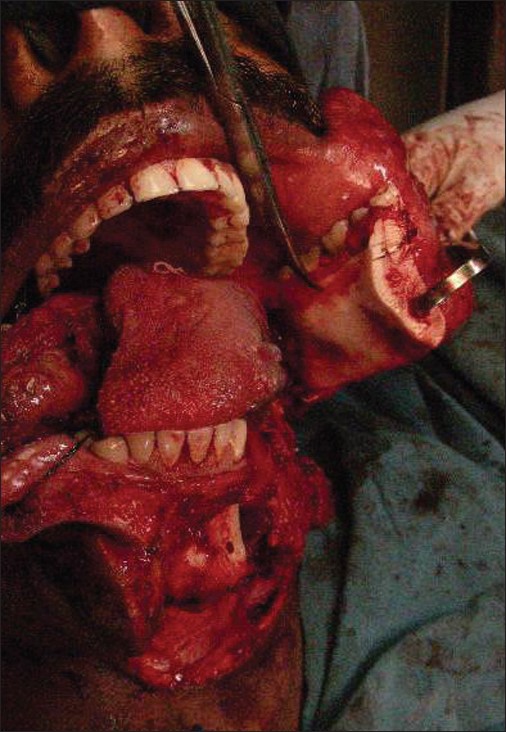  |
Flap hitching technique to the teeth after oral cancer resection |
p. 19 |
Krishnakumar Thankappan, Subramania Iyer, Mayuri Rajapurkar, Mohit Sharma, Pramod Subash
DOI:10.4103/2006-8808.100347 PMID:23066457Objectives: After resection of the tumors of oral cavity adjacent to the mandible, it is a common situation that the whole of one side of the gingival mucosal segment has to be stripped off the mandible to get an adequate margin. When a cutaneous flap is used for reconstruction, it has to be hitched to the teeth to get a watertight seal. We describe a technique to hitch the flap to the adjacent teeth in such an instance. Materials and Methods: The technique was applied in 10 patients with oral cancer, resected, and reconstructed with cutaneous flaps. Results: The technique was found to be effective in all 10 patients. Adequate seal was obtained in all patients. Oral diet was started within 7 days. Conclusion: An effective and simple technique to approximate a cutaneous flap to the teeth-bearing mandible, when all the mucosa is removed as part of oncological resection, is reported. |
| [ABSTRACT] [HTML Full text] [PDF] [Mobile Full text] [EPub] [PubMed] [Sword Plugin for Repository]Beta |
|
|
|
|
|
|
| SHORT TECHNIQUE |
 |
|
|
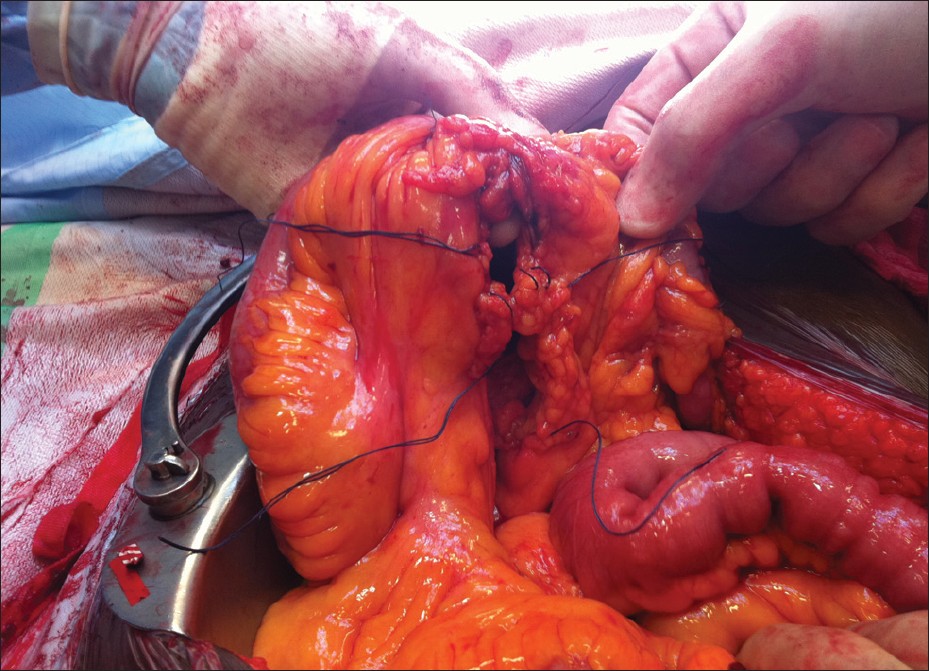  |
A simple technique for safe mesenteric defect closure following bowel resection |
p. 22 |
Yahya A Al Abed, Kevin Lafferty, Vasilis Kosmoliaptsis
DOI:10.4103/2006-8808.100348 PMID:23066458The closure of the mesenteric defect following bowel resection remains controversial. Proponents of the intervention cite the risk of bowel herniation through an open mesenteric defect and subsequent bowel obstruction whereas supporters of the opposing view advocate that such practice may lead to inadvertent compromise of the bowel blood supply. We describe a novel technique that enables efficient mesenteric defect closure while minimizing the risk of blood vessel injury. |
| [ABSTRACT] [HTML Full text] [PDF] [Mobile Full text] [EPub] [Citations (1) ] [PubMed] [Sword Plugin for Repository]Beta |
|
|
|
|
|
|
| CASE REPORTS |
 |
|
|
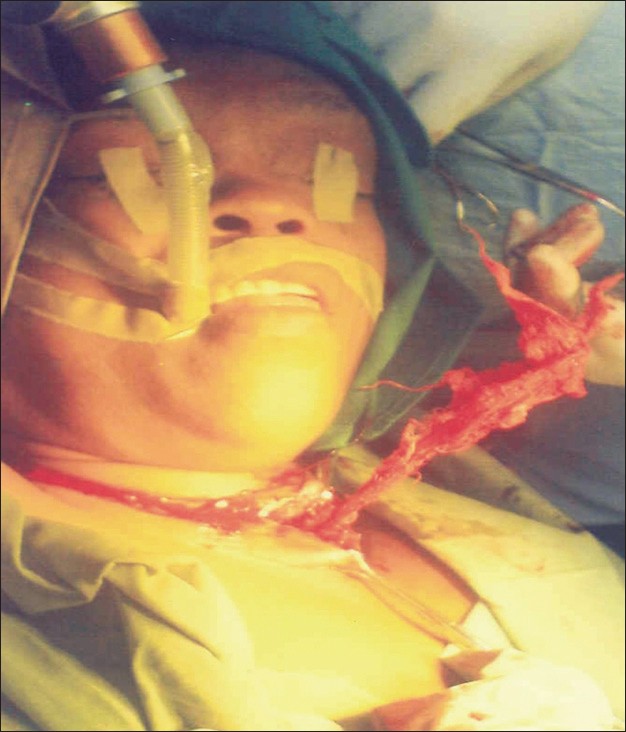  |
Failure to heal of thyroidectomy wound due to gossypiboma and stitch sinus: Report of two cases |
p. 24 |
Adewale A Musa, Adekunbi Banjo, Oladeji Agboola, Olubunmi Osinupebi
DOI:10.4103/2006-8808.100349 PMID:23066459This case series presents two females, 53 and 33 years old, with thyroidectomy wounds that failed to heal, 16 and 18 weeks, respectively, following the operation. The wounds were explored with removal of gauze and catgut suture. The patients made remarkable improvement and the wounds healed satisfactorily within seven days. Surgical materials forgotten intraoperatively, wrong use of and / or infected surgical materials should be considered when surgical wounds fail to heal. |
| [ABSTRACT] [HTML Full text] [PDF] [Mobile Full text] [EPub] [PubMed] [Sword Plugin for Repository]Beta |
|
|
|
|
|
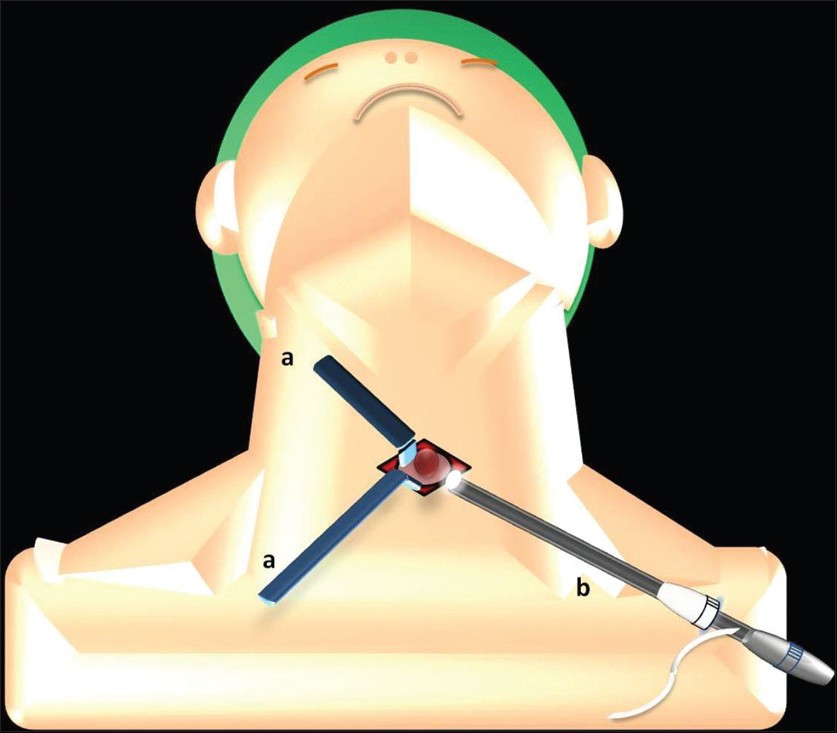  |
Gas-less video-assisted thyroidectomy for a solitary thyroid nodule: technical report of the first case performed at a rural teaching hospital in India and review of literature |
p. 27 |
Sanoop K Zachariah
PMID:23066460Minimally invasive thyroidectomy is still in its phase of evolution with various techniques being practiced only in certain centers internationally. The conventional thyroidectomy performed by the Kocher's cervicotomy often leaves an undesirable scar over the neck, the size of which is usually around 8-10 cm long. The main aim of minimally invasive thyroid surgery is to minimize or avoid the scar over the neck. Endoscopic thyroid surgery in India, especially in the state of Kerala, is still in its infancy. Here, we describe the first case report of a modified technique of video-assisted thyroid surgery using a laparoscope and conventional open surgical instruments. Video-assisted thyroidectomy enables adequate visualization of the operative field and provides a magnified view of the vital structures like the parathyroid gland, the recurrent laryngeal nerve, and the thyroid vasculature. The procedure described here can be considered as a more cost-effective alternative to the conventional minimally invasive video-assisted thyroidectomy (MIVAT), and therefore is feasible in a rural setup. |
| [ABSTRACT] [HTML Full text] [PDF] [Mobile Full text] [EPub] [PubMed] [Sword Plugin for Repository]Beta |
|
|
|
|
|
  |
Total laparoscopic management of a large renal hydatid cyst by using hydatid trocar cannula system |
p. 32 |
Saurabh Sudhir Chipde, Abhishek Yadav, Priyadarshi Ranjan, Anand Prakash, Rakesh Kapoor
DOI:10.4103/2006-8808.100351 PMID:23066461Renal hydatidosis usually requires surgical treatment such as pericystectomy, marsupialization, or nephrectomy. In the era of minimally invasive surgery, laparoscopic treatment is preferred. Two main challenges in laparoscopy are to avoid the spillage of contents and to minimize incision for delivering the specimen. We herein discuss the use of a hydatid trocar cannula system (HTCS) to overcome these problems. A 46-year-old male patient having a large renal hydatid cyst (18×15 cm) was operated using HTCS. Three standard laparoscopic ports were placed and the HTCS was placed from the fourth port (18 mm). After aspiration of contents, the cyst was inspected using laparoscope and all contents were sucked. The operation time was 120 min and the total blood loss was around 100 ml. No intraoperative spillage was noted. The patient was orally allowed on Day 2 and discharged on Day 3. Oral albendazole therapy was continued 3 months after the operation. He remained symptom free and abdominal computed tomography did not reveal any recurrences during a follow-up of 2 years. Use of HTCS in renal hydatidosis not only prevents the spillage of hydatid fluid, but also assists in the complete evacuation of contents and allows intracystic visualization to check complete removal of scolices. |
| [ABSTRACT] [HTML Full text] [PDF] [Mobile Full text] [EPub] [PubMed] [Sword Plugin for Repository]Beta |
|
|
|
|
|
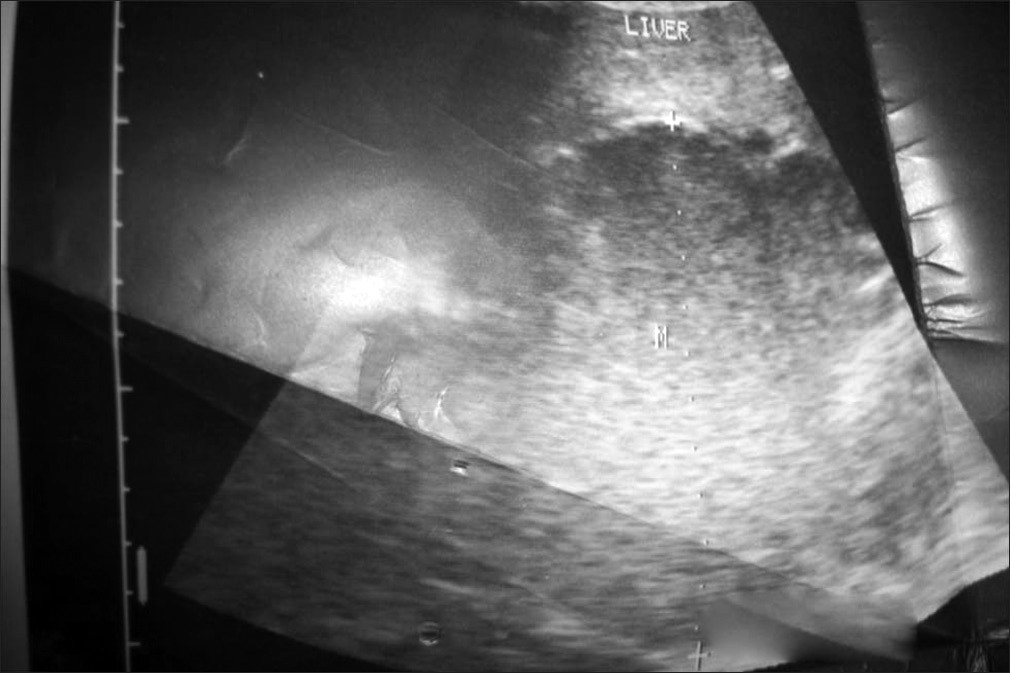  |
Laparoscopy-guided liver abscess drainage: An additional use of veress needle |
p. 36 |
Christopher N Ekwunife, Ernest C Amadi, Francis N Amaechi, Ifeanyi C Ukaha
DOI:10.4103/2006-8808.100352 PMID:23066462Percutaneous image-guided drainage is the standard of care in the treatment of liver abscess. However this may not suffice in multi-loculated abscesses and those associated with concomitant biliary pathology. We report the case of a 34 year old male who presented to our hospital with a huge hepatic abscess that could not be aspirated percutaneously. Subsequently he had a laparoscopic guided aspiration of the abscess, with the aid of veress needle. Three weeks post operatively, no residual abscess cavity was noticeable. We believe that minimal access surgery techniques should always be considered in the management of liver abscess, and that the veress needle can be an additional aspiration device, in our environment. |
| [ABSTRACT] [HTML Full text] [PDF] [Mobile Full text] [EPub] [PubMed] [Sword Plugin for Repository]Beta |
|
|
|
|
|
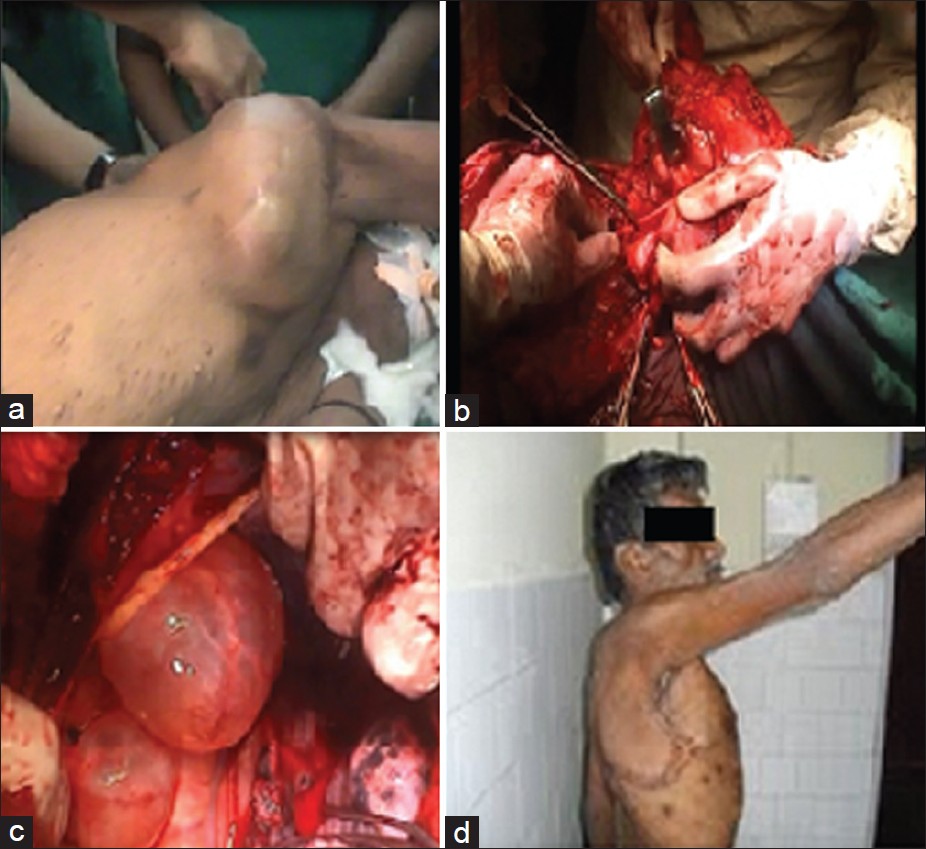  |
Coexistent malignant peripheral nerve sheath tumor and lateral spinal meningoceles |
p. 39 |
Lata Bhoir, Pramod Nichat, Ashish Chug, Harish Verma
DOI:10.4103/2006-8808.100353 PMID:23066463Malignant peripheral nerve sheath tumor (MPNST) is a malignant spindle cell tumor of the soft tissue thought to be derived from the components of nerve sheath. MPNSTs are mainly located in the buttocks, thighs, brachial plexus, and paraspinal region. The objective of this article is to describe a case of neurofibromatosis type 1 who developed neurofibrosarcoma of the right lateral thoracic nerve with thoracic meningoceles, a rare coincidental finding which has not yet been reported in the English medical literature, and how both the conditions were managed in the same sitting. |
| [ABSTRACT] [HTML Full text] [PDF] [Mobile Full text] [EPub] [PubMed] [Sword Plugin for Repository]Beta |
|
|
|
|
|
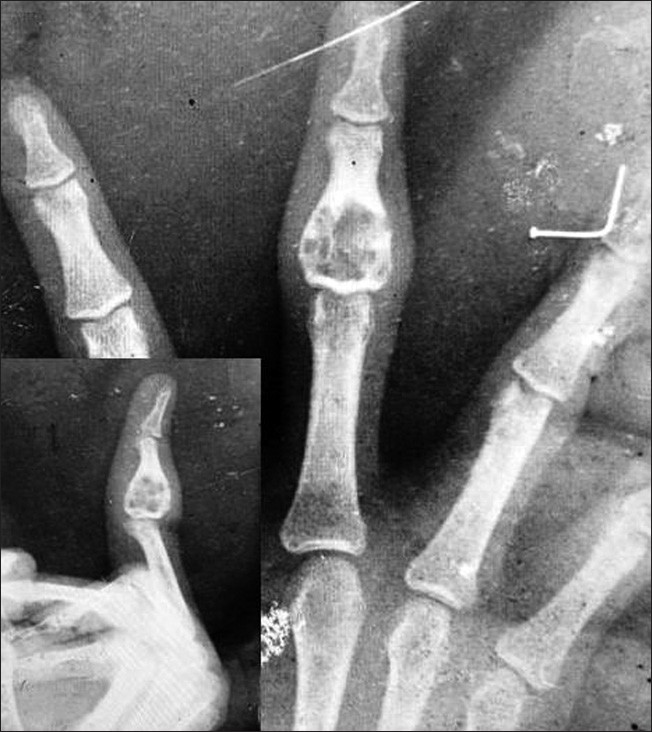  |
A rare case of chondromyxoid fibroma mimicking spina ventosa |
p. 43 |
Kalyan Khan, Arghya Bandyopadhyay
DOI:10.4103/2006-8808.100354 PMID:23066464Chondromyxoid fibroma (CMF) is perhaps the rarest of all bone tumors. Classically it occurs in the metaphyseal region of the long bones surrounding the knee. The small bones of the feet are also commonly involved. But CMF occurring in small bones of the hand, however, is very uncommon. Tuberculous dactylitis is referred to as spina ventosa. The bones of the hands are more frequently affected than bones of the feet. We present a rare case of CMF occurring in the middle phalanx of the left middle finger which was misdiagnosed as spina ventosa clinicoradiologically. It can be a common mistake especially in areas where prevalence of tuberculosis is still high. This case once again stresses the need for biopsy and to consider CMF as a rare differential diagnosis in all suspected cases of spina ventosa. |
| [ABSTRACT] [HTML Full text] [PDF] [Mobile Full text] [EPub] [PubMed] [Sword Plugin for Repository]Beta |
|
|
|
|
|
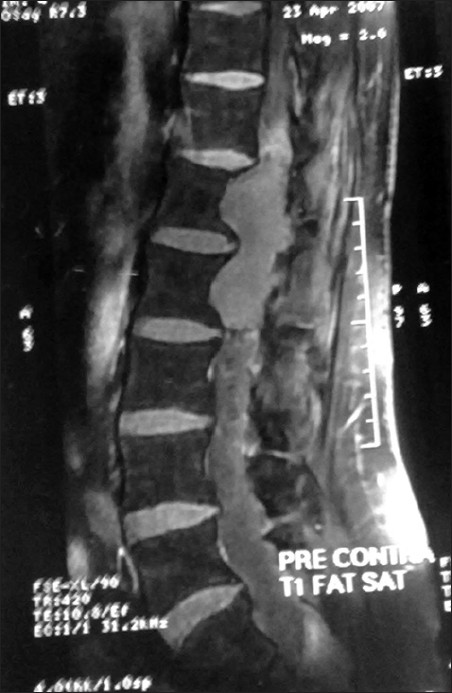  |
Functional paraganglioma: a rare conus-cauda lesion |
p. 46 |
Vivek Agrawal, Mally Rahul, Shadma Khan, Velho Vernon, Binayke Rachana
DOI:10.4103/2006-8808.100355 PMID:23066465Conus-cauda syndrome is caused due to involvement of the lower end of the spinal cord and arising bunch of nerve roots. It is caused commonly due to traumatic injury, spinal stenosis, spinal tumors, inflammatory, and infectious conditions, but paraganglioma is a rare cause. These tumors are rarely functional and secrete catecholamine. Till now only five case reports of functional spinal paragangliomas are available to the best of our knowledge. We report a 50-year-old hypertensive male patient with a lobulated lesion extending from lower border of D12 to L2, which was reported as ependymoma on imaging studies done preoperatively. This lesion was confirmed to be a functional paraganglioma postoperatively after the patient died because of its furious complication, thus highlighting the importance of its preoperative diagnosis and management. In conclusion conus-cauda functional paragangliomas are very rare entity. Diagnosing them in preoperative condition is critical from the therapeutic point of view, both medical and surgical. During surgery these tumors should be handled very gently to avoid spillage of catecholamines into blood. These tumors require assistance of expert anesthetist and endocrinologist in the perioperative period. |
| [ABSTRACT] [HTML Full text] [PDF] [Mobile Full text] [EPub] [PubMed] [Sword Plugin for Repository]Beta |
|
|
|
|
|
  |
Genitourinary plexiform neurofibroma mimicking sacrococcygeal teratoma |
p. 50 |
Abdulrasheed A Nasir, Lukman O Abdur-Rahman, Kazeem O. O. Ibrahim, Muideen A Adegoke, Joselp K Afolabi, James O Adeniran
DOI:10.4103/2006-8808.100356 PMID:23066466Neurofibromatosis is a common inherited autosomal dominant disease, but genitourinary neurofibroma is rare. The unpredictable nature of neurofibromas has a serious impact on the quality of life of patients, and their management is challenging for clinicians. We present a 9-year-old girl with plexiform neurofibroma of genitourinary system associated with pulmonary hypertension, masquerading as sacrococcygeal teratoma. Intraoperative finding and histological examination of the resected tumor confirmed the diagnosis. |
| [ABSTRACT] [HTML Full text] [PDF] [Mobile Full text] [EPub] [Citations (1) ] [PubMed] [Sword Plugin for Repository]Beta |
|
|
|
|
|
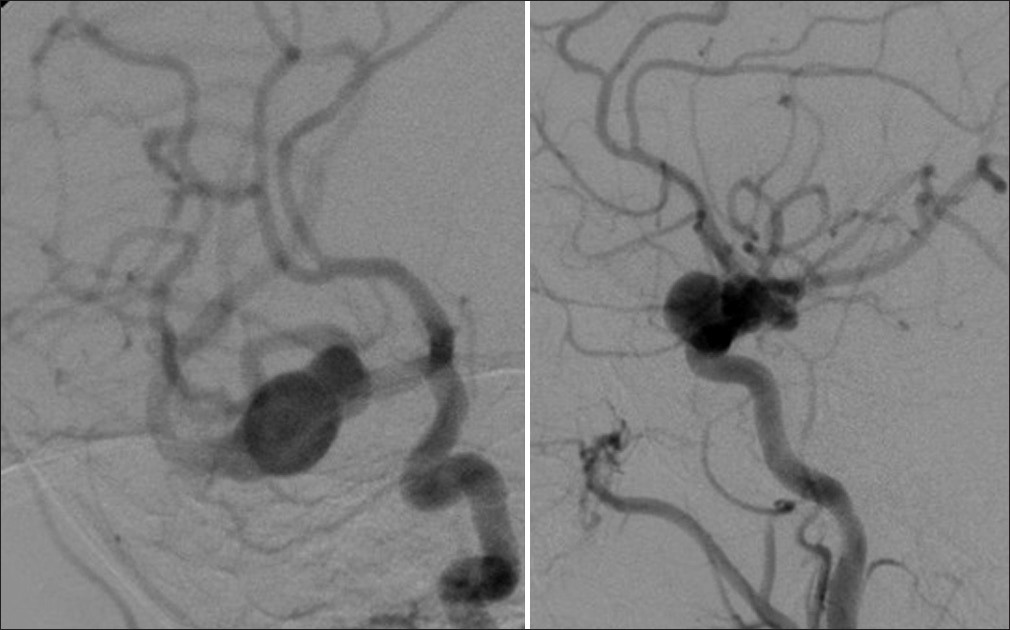  |
Direct, high-flow bypass for a pediatric giant, fusiform aneurysm of the inferior division of m2: Case report and review of literature |
p. 53 |
Vignesh K Alamanda, Luke Tomycz, Dennis Velez, Robert J Singer
DOI:10.4103/2006-8808.100357 PMID:23066467In this case report, we describe the first reported case of treating a 7-year-old male patient who has a giant, fusiform aneurysm confined to the inferior M2 segment by means of a saphenous vein graft. Given the lack of good endovascular management options for this particular scenario, craniotomy was recommended and an end-to-side ECA-ICA anastomosis was carried out with technical details of the surgery outlined in the manuscript. The patient did not sustain any major postoperative complications. The graft remained patent upon completion of the surgery and at the time of last follow-up, 9 months post-surgery. This case serves as an illustrative example of the need for high-flow bypass for a select few patients even as endovascular technology continues to improve. |
| [ABSTRACT] [HTML Full text] [PDF] [Mobile Full text] [EPub] [PubMed] [Sword Plugin for Repository]Beta |
|
|
|
|
|
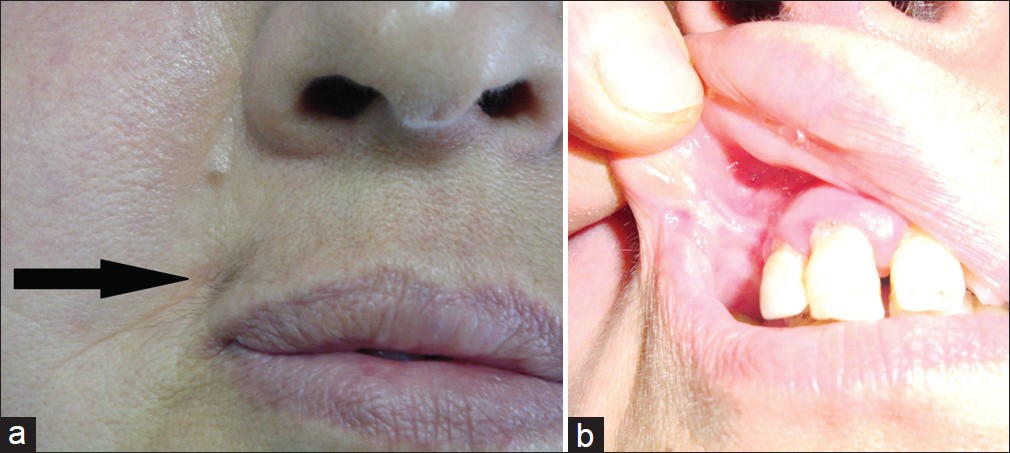  |
The use of a nasolabial island flap in vestibulo-sulcoplasty in a patient with recurrent depressed scar on the modiolus |
p. 58 |
Umut Tuncel, Aydin Turan, Naci Kostakoglu
DOI:10.4103/2006-8808.100358 PMID:23066468A 56-year-old woman with a recurrent depressed scar of the commissure, treated with a nasolabial island flap, is presented. On examination, the scar was located on the right modiolus involving the right upper gingivobuccal sulcus. A history of recurrent canine abscess was obtained. After excision of the scar and release of the vestibular fold, reconstruction of the defect was performed with a nasolabial island flap from the same side. The postoperative course was uneventful, with a good aesthetic and functional outcome. |
| [ABSTRACT] [HTML Full text] [PDF] [Mobile Full text] [EPub] [PubMed] [Sword Plugin for Repository]Beta |
|
|
|
|
|
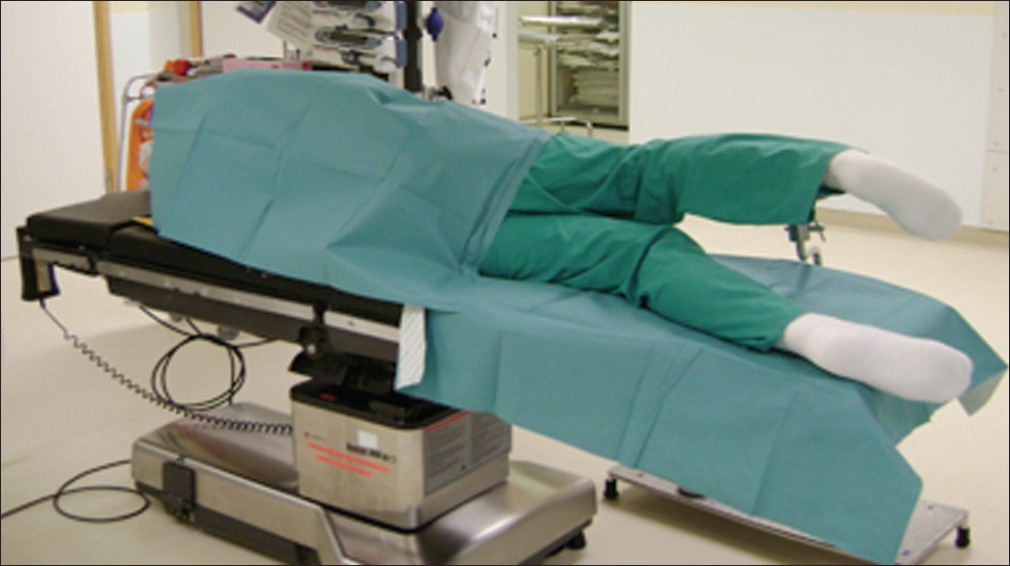  |
The short saphenous vein: A viable alternative conduit for coronary artery bypass grafts harvested using a novel technical approach |
p. 61 |
Umran Sarwar, Govind Chetty, Pradip Sarkar
DOI:10.4103/2006-8808.100359 PMID:23066469A multitude of vascular conduits are available to the Cardiac Surgeon performing Coronary Artery Bypass Graft operations. The Internal Mammary Artery, Radial Artery (RA), and the Long Saphenous Vein (LSV) have proven to be excellent conduits, especially in the current era of statin usage. However, previous stripping or varicosities of the LSV and calcification of the RA, coupled with the need for multiple vessel grafting, requires an alternative candidate. We describe a novel harvesting technique for bilateral simultaneous Short Saphenous Vein harvest and propose this, often forgotten vein, as a viable alternative conduit. |
| [ABSTRACT] [HTML Full text] [PDF] [Mobile Full text] [EPub] [PubMed] [Sword Plugin for Repository]Beta |
|
|
|
|
|
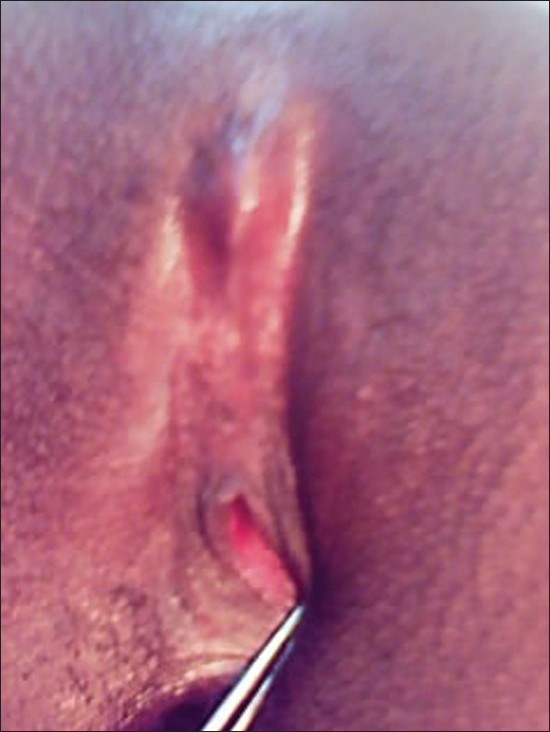  |
Urinary and genital tract obstruction as a complication of female genital mutilation: case report and literature review  |
p. 64 |
Obi Anselm Okwudili, Onoh Robinson Chukwudi
DOI:10.4103/2006-8808.100360 PMID:23066470Female genital mutilation (FGM) is the partial or total removal of the female external genitalia or other deliberate injury to the female genital organs, either for cultural or non-therapeutic reasons. This barbaric act is accompanied by a variety of complications ranging from hemorrhage, fracture, infective complications, gynetresia, with its attendant sexual and obstetric difficulties, and death. A 23-year-old girl, with urinary and genital tract obstruction following female genital mutilation(infibulation) is presented. She was managed by elective defibulation, with a satisfactory outcome. Robust health education strategies are needed for the eradication of FGM. |
| [ABSTRACT] [HTML Full text] [PDF] [Mobile Full text] [EPub] [Citations (1) ] [PubMed] [Sword Plugin for Repository]Beta |
|
|
|
|
|
|
| LETTER TO EDITOR |
 |
|
|
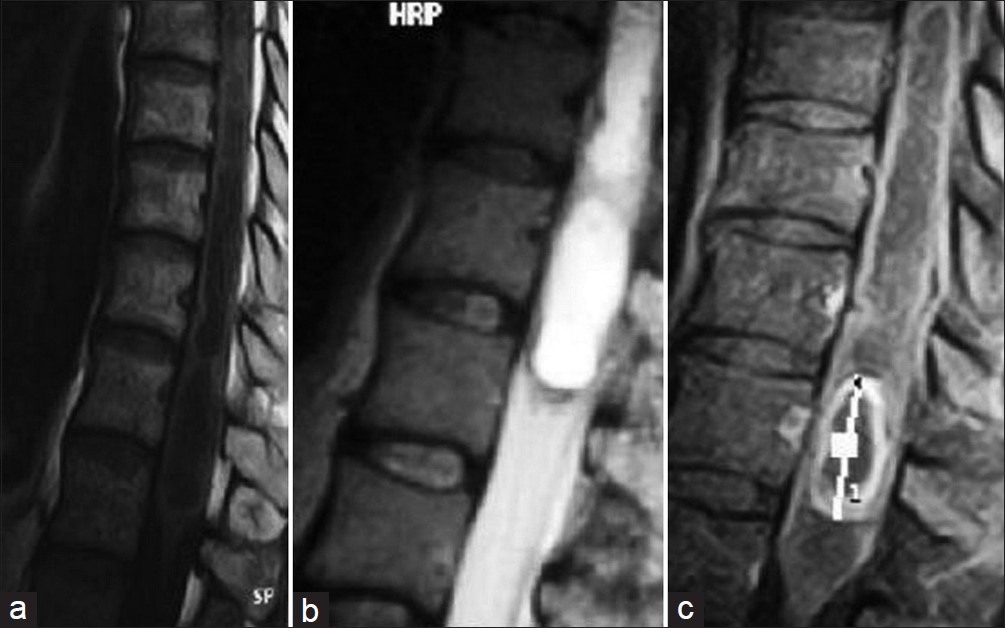  |
Rare tumor of conus medullaris in an adult with a favorable outcome |
p. 67 |
Ashish Kumar, Rajan M Shah, Nimit Gupta
DOI:10.4103/2006-8808.100361 PMID:23066471 |
| [HTML Full text] [PDF] [Mobile Full text] [EPub] [PubMed] [Sword Plugin for Repository]Beta |
|
|
|
|
|